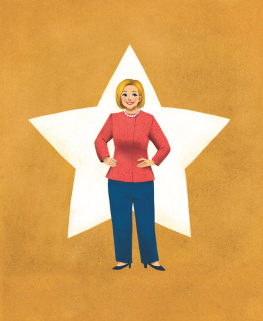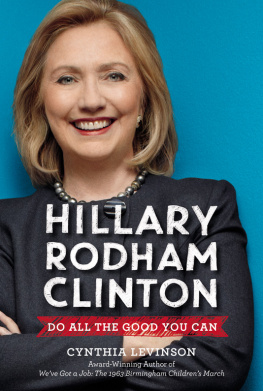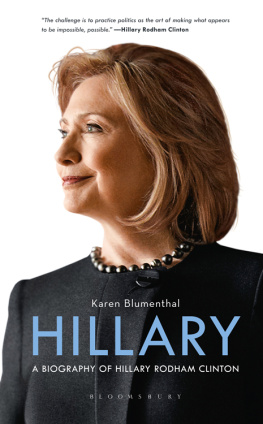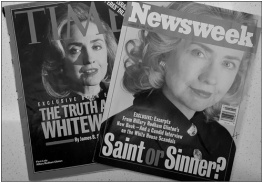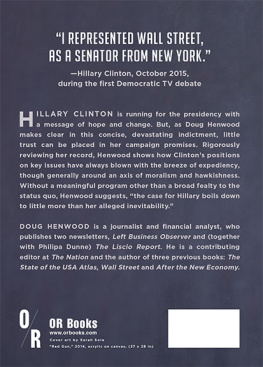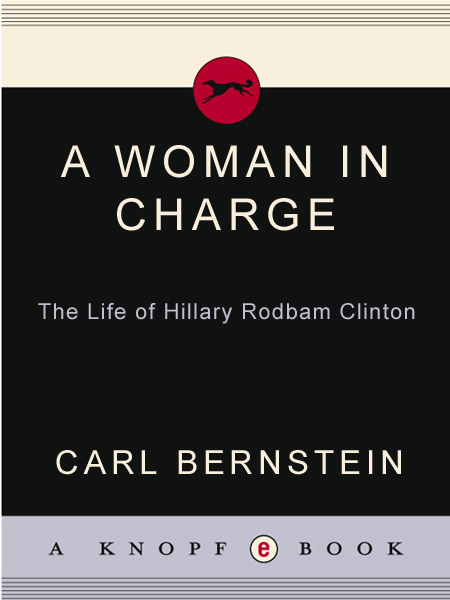
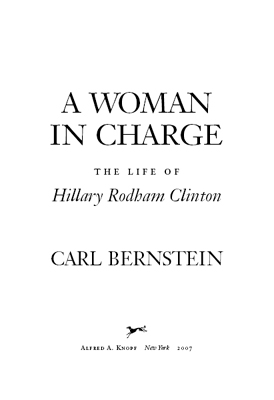
CONTENTS
For Christine
Prologue
What I did and said in the next days and weeks would influence not just Bills future and mine, but also Americas. As for my marriage, it hung in the balance, too, and I wasnt at all sure which way the scale would, or should, tip.
Hillary Rodham Clinton, Living History
T OWARD NOON on February 12, 1999, Hillary Rodham Clinton, wearing sensible pants, a simple top, flat shoes, and a smile, strode into her sitting room, with its majestic view of the capitals great Mall. The meeting she was about to convene would change the course of her life and (to an extent yet to be determined) the history of her country. Since the day she had met Bill Clinton in 1970, she had stood by her man through all manner of harrowing twists and turns, including (most famously and most recently) the national out-of-body experience known as the Lewinsky affair, on this day reaching its long overdue denouement. More than a year had passed since she (and the country) had first heard the name Monica Lewinsky, a year in which her world had been turned upside down, and Washington with it. Now Hillary Clinton was about to cut loosethough not from her marriage, necessarily, or from Washington, or from her tether to the national consciousness. Rather, a profound alteration in her relationship to all three was reaching critical mass: she was moving toward a final decision on whether to run for the United States Senate from the state of New York, where she had never lived, and to become the first first lady to run for office.
Downstairs in the Oval Office, the president was receiving reports from aides glued grimly to television pictures of the chamber to which his wife aspired. As the Senates one hundred members were called to order by the chief justice of the United States, the relative solemnity of the occasion was indicated by the special robes William H. Rehnquist had designed for himself to wear at the presidents trial. Their gold-embroidered, striped, and ruffled sleeves had been inspired, appropriately, by a Gilbert and Sullivan operetta.
On each senators desk lay a red leather folder containing the formal, printed chargesperjury and obstruction of justiceagainst the president, and a tally sheet to track the vote. The result of the roll call about to begin was a foregone conclusion. A two-thirds majority was required to convict, and it was known that only Republicans would cast ballots in favor: forty-five on the first charge, fifty on the second. Clinton, the first president to be impeached by the House of Representatives since Andrew Johnson in 1868, would be acquitted of high crimes and misdemeanors.
Clinton would survive in office due principally to the actions of his wife, just as their tangled relationshipmore than any other factor, arguablywas central to his being impeached in the first place.
Seven years later, Bill Clinton was trying to figure out what to do with his life. She, meanwhile, was trying to become president. After a single term in the Senate, she had transformed herself from first ladycuckold to the most talked about and important leader of her party, the most polarizing politician in the land, a senator like no other, a celebrity like no other, taking the country on another wild Clintonian ride as she became close to omnipresent in what passed for sociopolitical dominanceon TV, in arguments every night at dinner tables all over America, in the foreign press, among her Senate colleagues, in the precincts of the supposed vast right-wing conspiracy that had tried to kill Clintonism. By the time of her overwhelming reelection to the Senate in 2006, she had inspired a nonstop national and international dialogue about herselfher politics, her business acumen, her future, her morals, her sexuality, her religion, her looks, her marriage (still). Single-handedly, she had reanimated the enemies of Clintonism to new heights of fear and frenzy. The public attention drawn to her person, abetted by a press whose hunger she fed unabatedly, at times exceeded even that of the incumbent president, who had been declared elected in 2000 by the same chief justice who wore the Gilbert and Sullivan robes and his colleagues on the Supreme Court. George W. Bush, winner of the first presidential election in American history to be decided not by the electorate but by the judiciary, had prevailed following a campaign promising voters that he would restore honor and traditional American values to the White House after its desecration by the Clintons. Plural.
Yet, as the disastrous presidency of her husbands successor neared expiration, Hillary Clinton, in a nation besotted with celebrity, had come to a prominence unique in her timesettling in a rarefied place never populated even by FDR, Princess Diana, Ike, Oprah, or Eleanor Roosevelt as, in a great cacophony, people from every station and walk of life (plus talk show hosts and the National Enquirer) fulminated, debated, and screamed at one another about her. Those abroad asked Americans they encountered: Who is she? Do you like her? Will she become president? Is she gay? Meanwhile, she continued to play the U.S. Senate like a flute, charming her colleagues on both sides of the aisle, raising record funds for members of her own party (and preparing the financial ground for her own presidential campaign), entertaining the troops in Iraq, and carefully supporting their mission while looking for ways to separate herself from the policies of the president who sent them there, and from her own vote that had helped dispatch them.
In all this, Bill Clinton had become her biggest booster as, roles now reversed, the gears of the Clinton apparat shifted and another Clinton sought the presidency. He was now a constant presence in the background as her counsel, consultant, strategist, and, finally, the elemental part of her process as a woman in charge.
A FEW MINUTES after the Senate had voted to acquit her husband and the thump of the chief justices gavel had ended his trial in the Capitol, Hillary had finished up her meeting in the White House with Harold Ickes. Hillary and Ickes, her unofficial deputy, had been the architects of successful strategies to save the Clinton presidency at various points. It had been Hillary, who, at the darkest moment, while others were floundering, had assigned a fanatically loyal entourage of men and women to report Sunday mornings to plan for the battle ahead as the impeachment process hurtled down the tracks, braked in a deafening screech, and came to a halt in the Senate chamber. Ickes, the presidents former deputy chief of staff, is the son of Harold Ickes, one of the most distinguished elders of the Democratic Party. It had been Harold Sr., FDRs confidant and secretary of the interior, who in 1945 had met with Eleanor Roosevelt shortly after her husbands death to urge her to enter electoral politics and run for governor in New York. After intense examination, political and emotional, she had rejected the idea.
Ickes Sr., like his son, had been equally close to the president and first lady, and had helped Eleanor adjust to the hatred and enmity engendered by her principles, politics, and participation in the presidency of her husbandthe last Democratic president to be elected and reelected before Bill Clinton.
Harold Jr., a master of New Yorks ice-pick-pointed politics, was ambivalent about whether Hillary should run for the Senate to succeed Daniel Patrick Moynihan, and he was forthright that afternoon about presenting all the obstacles of such a course, not least of which would be inevitable stories about the hostility (finally diminishing as Moynihan neared retirement) between the outgoing senator and the first lady. In the end, Harold Jr. had a much more willing and motivated candidate than his father had had a half century earlier with Eleanorwhom Hillary Clinton idolized. Hillary was seeking not just a seat in the Senate, but redemption: hers, her husbands, and the Clinton presidencys.
Next page

